Sujata Massey's Blog, page 9
July 14, 2021
Women in Period Costume, Facing Away
This post originally appeared on Murder Is Everywhere.
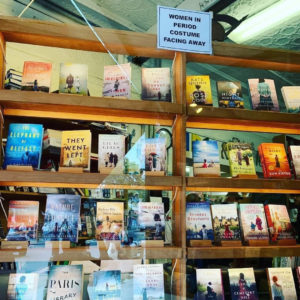 photo by Sarah Kinney Gaventa at Sherman’s Books
photo by Sarah Kinney Gaventa at Sherman’s BooksTake a good look at this picture of the shelves in Sherman’s Books, an indy bookstore in Bar Harbor, Maine. The hand-written sign above the book display reads:
WOMEN IN PERIOD COSTUME FACING AWAY
It’s picture that’s been shared, and reshared, among Facebook friends this week. We laugh amongst ourselves because a lot of our books are just like this, featuring ladies looking away. And that raised a question I’m trying to answer for myself. What is it that drives publishing house art departments to almost universally introduce women characters from behind?
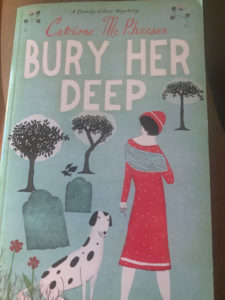
My first thought is the image is meant to proclaim the book is trade fiction. Mass market historical romances show faces and bosoms of women—often locked in embrace with dashing men.
There’s also the point of universal appeal. An editor told me that readers can have strong personal reactions to faces. Readers might turn away from a book if a face doesn’t appeal. They are less likely to read a book if the cover model’s face—whether photographed, painted or sketched—is dislikable to them.
This brings up the idea of bias. Are we prejudiced against people who are too pretty or too young—or not pretty enough? Do we like to see a protagonist who could be our peer and friend? Do we make subconscious connections between photographs and drawings to real people in our past?
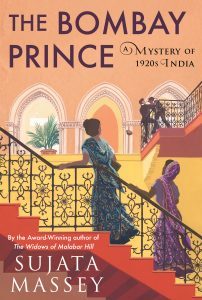
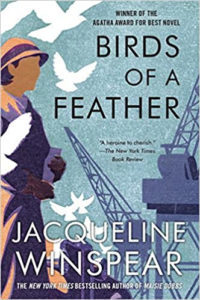 Two Andrew Davidson book jackets: mine and Jaqueline Winspear’s
Two Andrew Davidson book jackets: mine and Jaqueline Winspear’sMy Perveen Mistry series books feature covers designed for the Soho Press by an artist named Andrew Davidson, who also does the covers for Jacqueline Winspear’s Maisie Dobbs novels (which also started at Soho, but now are published by HarperCollins). Davidson is brilliant at producing a cover that has the same stylistic feel and dimensions as commercial art from the 1920s and 1930s. And another great part of this artist’s process is that he requests examples of clothing, hats, and buildings. I’ve sent photographs and film clips and closeups from textile museum catalogs. Cover consultation is one of the rights in my book contracts, and I enjoy the collaboration. One part of the design process is me providing illustrations of clothing and hats for my characters, and other period touches.
Perveen Mistry novels in other countries may reproduce the same covers from Soho Press, while other international publishers have artists draw designs they consider better suited for their own markets. In Australia and India, Perveen Mistry reveals both body and face—properly clad, of course. And something of note: in Australia, Perveen is brown. In India, she’s golden.
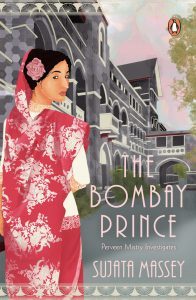 Penguin India Cover
Penguin India Cover Allen & Unwin Australia cover
Allen & Unwin Australia coverAnother cover trend in so-called women’s fiction is a partial view of women’s faces. I notice this often when the books feature characters of color.
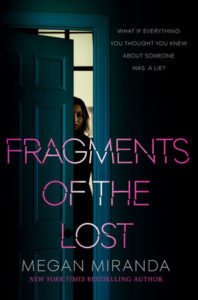
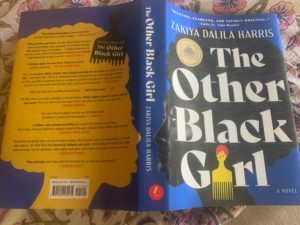

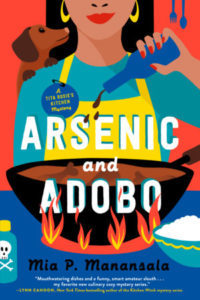
And speaking of men… we all know that many character-driven historic and contemporary novels feature male heroes. Yet where are the manly eyes, noses, and beards? These book jackets don’t show faces—just abstract designs, boats, bridges, mountains, imposing buildings, freeways, streets, alleys, cars, and machinery.
Sigh. Sometimes it feels like we never left kindergarten. And because it is 2021, I am putting out the call for male authors to ask their publishers to put men on book jackets. It seems fitting that everyone get the same chance for pranking in bookstores.
The post Women in Period Costume, Facing Away appeared first on Sujata Massey.
June 30, 2021
Hot Enough To Fry a Pancake
This post originally appeared on Murder Is Everywhere.

A little more than a week ago, I was lying in a darkened bedroom at 4 PM on a Friday afternoon—wracked with fatigue, weakness and thirst.
The day had started splendidly. I’d driven about 40 miles to the Washington suburbs to visit with my new author friend Shauna Singh Baldwin, a Wisconsin-based writer who was visiting a school friend who lived there. Shauna had been chatting with me the night before about my new book. It was cool at 8:30, when we walked—Shauna, her friend Ruma, and me. I wore a hat, sunscreen and sunglasses and took a sun protection supplement. Oh, yes—the top below is my favorite 50 SPF rash guard. I have to take extra precautions due to medication-induced sun sensitivity. I’m on Shauna’s left.
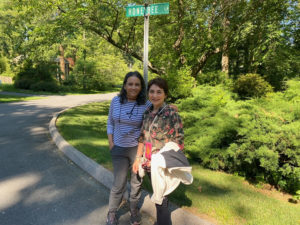
Because I was making this drive, an opportunity rose in my mind for GOOD FOOD. Specifically, South Indian food. In Baltimore, the South Asian diaspora is mostly represented North Indian and Nepali restaurants. The Washington, DC, suburbs have more diverse cuisines. I’d been longing for a dish called uthappam, a pancake of fermented rice and lentil flours that’s studded with tiny bits of vegetables and chillies. Next to dosa, uthappam is one of South India’s most popular exports, served all around India. There’s a special magic to its fermented sour taste. If you’ve tasted dosa, you’ll recognize uthappam as a less glamorous, heartier cousin.
The picture below is how Wikipedia defines uthappam.

The ladies and I had a glorious time on the walk through shady neighborhood streets. I told Shauna’s friend, Ruma, about my desire for uthappam. To save time, Ruma recommended that I save time by foregoing the restaurant I’d planned to drive to in Gaithersburg. She was a fan of a restaurant called Chettinadu in Rockville, a suburb near Bethesda.
I said goodbye to my friends, applied more sunscreen, and took off. Due to roadwork and closed lanes, the drive through suburban streets to Rockville took as long as my earlier drive from Baltimore to Bethesda. This translated to about 40 minutes of one-way driving, with the mid-morning sun blazing through my windshield. I felt it. had the brim of my hat pulled low and sunglasses on and a surgical mask covering my lower face. As the sunlight intensified, and the car moved along at ten miles and hour, I thought to myself, I’m doing all of this for a spicy pancake?
Chettinadu’s storefront marquee was at the back of a large shopping center parking lot. I’ve come to take this as an auspicious sign, when it comes to small international restaurants. I exited my car under a cloudless sky and walked a couple of agonizing, overheated minutes to the restaurant. Still fully shielded by hat, mask and dark glasses, I slunk into the restaurant like a too-obvious spy and sat down to wait for my order to finish cooking. You see, in addition to uthappam, I’d ordered a plain pancake known as appam, a mixed vegetable curry, a chicken curry, vadas, and rasam.
The sun didn’t give me a break on the ride home, and I didn’t feel well when I got inside. I drank more water, ate a little vegetable curry and ate a quarter of the uthappam. Then I toppled into bed. I felt strange. It’s hard to explain, but I was thirsty, and very, very tired, in a way that didn’t feel restful, though I did fall asleep.
Fortunately, it was not actual sunstroke, in which I might have sprung a temperature. This sun exhaustion was almost surely caused by a drug reaction, I learned as I looked at the profiles of two meds I’d taken the day before my car trip. I was so much better the next morning and attacked the uthappam again at breakfast and lunch. I didn’t have any left the day after, and I wanted more.
But not that drive.
I told myself that if I could make my own uthappam. Many uthappam recipes are in South Indian cookbooks and online. There also are myriad websites where Indian home cooks are sharing healthier versions of classic recipes.
I was more confident than wise.
I attempted a classic uthappam batter, which ferments up to 20 hours and is made with soaked urad dal and parboiled rice. Both ingredients soften in water for 6 hours and are then ground together with their soaking water into a batter. The batter then ferments from eight to twenty hours.
It turned out that my air-conditioned house is too cold for this batter to ferment, and my screened porch simply too hot to do anything except grow blue and yellow bacteria spots on the surface. For this kind of cooking, you need a mother, aunty, or South Indian chef looking over your shoulder.
It wasn’t time to quit. I could attempt one of the new, instant uthappam recipes from the armies of Indian food bloggers. They are instant in the sense that they use a little yogurt or baking soda to get the batter bubbly. Here are the ingredients before mixing and the finished batter below.
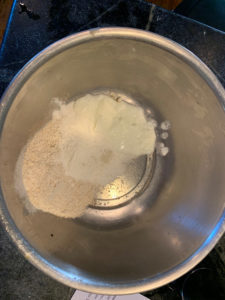
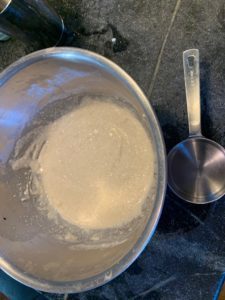
I defaulted to easy by picking a recipe calling for ingredients that were already in my house. Indians are increasingly health conscious and making changes to traditional dishes. Several uthappam recipes using oats as the main flour caught my eye. I decided to try “oatmeal uthappam,” in which rolled oats are ground into a kind of flour or left whole if they are instant oats. The batter doesn’t ferment overnight like classic recipes, but it has a good bacteria boost from probiotic plain yogurt.
The pancake was quite thick, as the recipe author warned, and it took three tries till I could get it to semi-uthappam shape—although it was uneven. Quickly I discovered less is more with the vegetables toppings, and given the fibrous quality of oatmeal, water must be added to make the batter suitably thin. Spreading the batter had to be fast and the vegetables needed to scatter within the next 30 seconds and be gently pressed down. I arranged everything right next to the frying pan and worked as fast as I could.


In India, uthappam are fried on a tawa, which looks like a large round frying pan, typically cast iron or aluminum. I found cast iron worked better for me than stainless.
Broken pancakes would never be served at Chettinadu, but they were at my house. And there was a pleasant tang. I at the second pancake, because the first was an utter ruin, and by the third pancake, I had one that flipped out of the pan and into the plate without breaking. Although it still wasn’t round.
In a way, making these pancakes was a lot like trying to write a book. My pages are a mess at first—I’ve just got to keep returning to the work and learning my way through the story. With practice, we inevitably get the skills.
I judged my uttapam a 6 out of 10, and my husband gave it a 9.
So the third one was better!
Here’s the recipe I tried by food blogger Swasthi from Indian Healthy Recipes.
The post Hot Enough To Fry a Pancake appeared first on Sujata Massey.
June 16, 2021
A Tiny Guessing Game
This post originally appeared on Murder Is Everywhere.
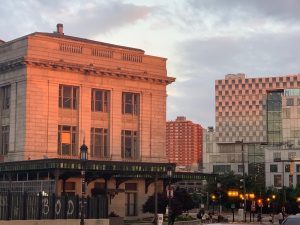 Click on the photo to enlarge it!
Click on the photo to enlarge it!Can you guess the name of this building?
Recent travels, lots of book Zooming, and the vines in my garden are conspiring to make me a trifle overwhelmed. But there is beauty in the chaos, and the world is opening up… truly it is.
My eye was caught by this magnificent urban building at sunset, and I wonder if anyone looking at the building will recognize it. Hint: it’s accessible by train. Leave your guess in the comments section.
P.S. If you are in the mood for some book banter on Thursday night (6/17/2021), I will be zooming FROM MY KITCHEN at 7 PM Central Standard Time. My interlocutor is the phenomenal historical fiction author Shauna Singh Baldwin and our host is the Boswell Book Company of Milwaukee. The link to join this live book talk in webinar format is here.
The post A Tiny Guessing Game appeared first on Sujata Massey.
June 2, 2021
Launching The Bombay Prince
This post originally appeared on Murder Is Everywhere.
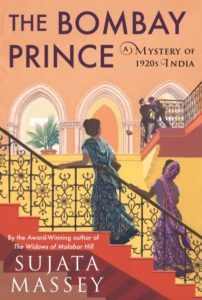
Tonight I am feeling BOLD!
Just a few hours ago, I ripped off my mask and greeted an audience on a packed patio at The Ivy Bookshop in Baltimore for a book-signing. Soho Press’s edition of The Bombay Prince, my first book in two years, has launched into the world.
It’s a very exciting, and slightly daring, experience to launch a book in a community that is probably 2/3 vaccinated, even though we were outdoors. I imagined many people hadn’t been that close to so many others in over a year. And you could say thousands were there—because of the cicadas in the four-plus acres of gardens connected to the bookstore.
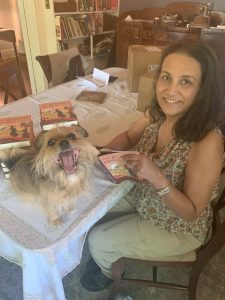 Little Daisy has the mouth of a publicist
Little Daisy has the mouth of a publicistI thanked the friends who’d come for their patience. This was a book I labored over for a longer period of time than I usually allow myself. I went to India twice to research this book twice. The final research trip, which involved getting inside a historic college and touring a police station, happened just a month before COVID closed the world down. How lucky I was to have been in India before it was too late.
The third novel in my Perveen Mistry series delves deep into the political conflicts in 1921 India between India’s British ruling class and Indian subjects desperate for autonomy.
The book’s heroine, solicitor Perveen Mistry, is caught between two worlds. She yearns for her country to be free, while many of her family and friends prefer the status quo. They don’t want to imagine what the city would be like without familiar faces controlling the courts and government. This conflict comes to a head when Edward VIII, Prince of Wales, travels through the city in a gala procession, during which time one student protestor is arrested, and the other, a female, is discovered dead on the college grounds. The immediate assumption is that the girl’s death was an act of political suicide or vengeance. Perveen assists her grieving family and finds the truth is more frightening—and may even portend violence against the visiting English prince.
 PRH India cover illustration inspired by Wilson College!
PRH India cover illustration inspired by Wilson College!I like combining true stories like the prince’s 1921 visit to India and subsequent riots with personal stories that come from my own imagination. I became curious about the lives of early college coeds after reading an article in a student magazine written by an “Anonymous Lady Student.” Another great source were articles by newspaper correspondents about the Prince’s visit and the ensuing riots, and the British government’s account of the Prince’s daily schedule, which formed the backbone of my novel’s schedule. Perhaps few care about whether the Prince of Wales actually visited the Orient Club on Sunday versus Monday, but since he is a real person, I want to get that right.
There is a special poignancy in promoting a novel about India during this time, when India was unexpectedly slammed with the most lethal COVID-19 experience we’ve seen so far. I’m desperately concerned for Bombay and the wonderful people I know there. I comfort myself by knowing, through history, how India has always come back strongly from difficulties.
 Allen & Unwin’s charming Australia/NZ edition
Allen & Unwin’s charming Australia/NZ editionThe Bombay Prince launch continues throughout the summer, mostly virtually, with online events sponsored by some of the nicest book people in America. Different literary friends will be in conversation with me at the various events, so the conversations will be unique with audience participation welcomed. All are free but require registering ahead of time to get a joining link.
You can bless these wonderful booksellers by getting a book from one of them—it’s even possible to do so while watching the event online. The book is also just released in Australia and New Zealand from by Allen and Unwin, and will soon will be out in India from Penguin India/Random House. I hope to have online gatherings for readers in these countries. I’ll let you know when the schedule comes together. Also, the audiobook read by the sublime Sneha Mathan is available from Recorded Books. How I love to listen to her voice!
Lastly, I want to say that many people are involved in the making and launching of a book—from agents and editors and marketing people, to other authors, booksellers, bloggers and readers. I am grateful to every single person who’s discovered and shared Perveen—including you.
The post Launching The Bombay Prince appeared first on Sujata Massey.
May 19, 2021
The Great Cicada Summer
This post originally appeared on Murder Is Everywhere.
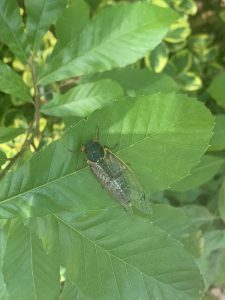 Hello, 2021!
Hello, 2021!All over Maryland, there’s one sweet word I hear every day: cicada.
The cicadas are here.
Or, should I say, Magicicada? Or to be very precise—I can’t say it, but I can spell Magicicada septendecim, Magicicada Cassini and Magicicada septenecula, the three species making up Brood X which is based in Maryland and the Mid-Atlantic states nearby.
Do you know cicadas? They are much nicer than locusts. They don’t eat leaves, for a start.
They are such special “here today, gone tomorrow” friends. They bury to the ground as nymphs, wait seventeen years, and then come out to say hello. I am talking about a very special flying insect that emerges in eastern North America after a thirteen- or seventeen-year-long hibernation underground. This brood of cicadas manages to survive predators like birds and other small mammals by bursting forth in such numbers that the predators can eat their fill, and there are still enough left to mate and lay eggs for the future. Scientists don’t know if cicadas have an internal body clock that gives them a mid-spring alarm wake-up. That is one long battery, to go for seventeen years.
And what do cicadas have to do with writing? Well, some of us take seventeen years to get a career going. Others take seventeen years to write one book. Cicadas know how much time it takes to make art.
[image error]Molting on trees, where cicadas leave their exoskeletons[image error]Hey, that old suit just isn’t me!Maryland rightly considers itself the world’s cicada capital because our area has been home (for perhaps 40 and 200 million years!) to a brood (species) that is the largest in the country. The estimated density of a cicada emergence is 1.5 million emerging per acre. Before you start imagining my cicada summer as a sci-fi horror movie, let me confess I only saw two cicadas today during two hours of weeding. This could be related to environmental change, including the gardening “improvements” we’ve done, digging deep and adding more earth in various places. I was weeding this afternoon and only saw two cicadas. But when I walk through my neighborhood, I’m relieved to see some streets have healthy populations.
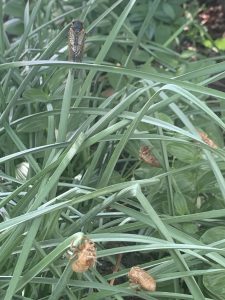 Looking for love in the right place
Looking for love in the right placeI remember so many more cicadas in years past.
My first experience was in 1987, when I was a young reporter at the Baltimore Evening Sun. I remember cicadas flying into my hair when I was leaving my city apartment for work and going out in early evening on dates. I saw their shells littered on the pavement. drove through wooded areas, the sound of the male cicadas contracting their abdominal muscles was like the most overpowering techno music. A single cicada can make noise of 110 decibels, on par with a lawn mower. They definitely interfered with the outdoor bar scene.
I was a young mother for the next generation of Brood X in 2004. I recall the kids swinging on swings and climbing up slides, not running in fear from flying bugs. But I wasn’t that focused on appreciating the cicadas. It was the height of the Iraq War, and the Navy had recalled my husband to active duty. Would he go to the front lines in the Middle East or somewhere else? How would I manage the young kids and finish the book that was due? The cicadas’ songs could not drown out the panicked noise in my head.
This time around, the cicadas arrived the week after my daughter’s death. At the start of April I’d told her they would be flying all summer, and she’d winced, anticipating an insect invasion she didn’t remember from her childhood. But she missed every one of them. Neel’s here and keeping his eyes out, but he’s still waiting for the big show. As a musician, it could impact the outdoor concerts he hopes to play. My husband is anxious for the cicadas’ well-being, carefully lifting them off his car tires so they don’t perish, and dissing the few neighbors who have chosen to protect young trees with fine mesh.
As I watch the cicadas crawl up trees to gather strength, and burst from their shells, I marvel at their steadfastness—and how patiently they wait, underground, for a few dazzling weeks of communal joy.
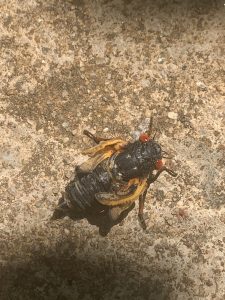 I may see red, but I’m not dangerous!
I may see red, but I’m not dangerous!The post The Great Cicada Summer appeared first on Sujata Massey.
May 5, 2021
A Daughter’s Passing
This post originally appeared on Murder Is Everywhere.

On that morning, who says I’m not there?
I’m in the stars, in the stars
In the blades of the grass
In the wind, in the wind
In the blue of the sky.
—Rabindranath Tagore
My father read this comforting poem to me over Zoom last week, and I wept.
Our family had suffered the unthinkable: the death of a child. On April 18, 2021, my daughter Pia Massey passed away, with cause of death yet to be determined. This shock has turned the beautiful spring into a very sad season for our family.
I’m guessing most readers of this column already have had the experience of losing a beloved relative or best friend, a teacher or therapist. I feel like my 22-year-old daughter was a little of all these things.
I first met Pia in Kerala, India, in December 1998, when she was a little over six months old. Her birth mother, Jasmine, spent her third trimester at a privately run orphanage and shelter providing housing and prenatal care for women with unplanned pregnancies. The organization worked with CARA, the Central Adoption Registry Agency, which is based in Delhi, and adoption agencies in India and overseas to find the right family for each relinquished child. There were cases wherein single mothers staying in this place kept their babies—very rare in India, but it made me glad that this also happened. My sister Rekha was with me during this trip, making it much easier for the novice mother to take care of a baby who was just learning to crawl. We were further aided by our relatives, the Parikh and Banerjee families in Kolkata, where we stayed while waiting for the immigration process to complete.
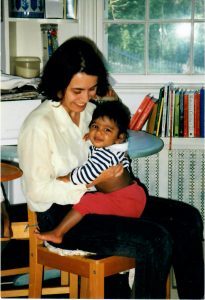
When I carried Pia into the United States, she was almost 9 months old. My husband Tony was relieved and elated to meet her after the months of waiting. He’d stocked our freezer with microwaveable servings he’d made of dal, the Indian lentil dish she already knew.
Pia was a lively, verbal toddler, at which time we adopted our second child, her brother Neel, three years younger, and from the same place in Kerala. Pia did kindergarten through the first half of second grade in Baltimore. Then we all moved to Minneapolis, Minnesota for six years, where she finished elementary school and started middle school. In 2013, Pia returned to Baltimore, and graduated from the Baltimore Polytechnic Institute, a public high school with a focus on math and science.
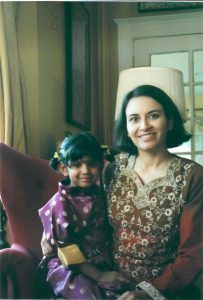
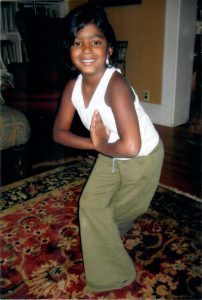
Beginning at the age of ten, Pia did volunteer work with babies at her orphanage when we returned to visit twice—her second visit was at age sixteen. During Pia’s high school years, she volunteered with children at Camp St. Vincent in East Baltimore and Stony Run Friends’ First Day School. Pia studied at Towson University and Montgomery College, with a special interest in psychology and criminal justice. She worked for a year as a phlebotomist with the Pennsylvania Red Cross, a job she enjoyed very much.
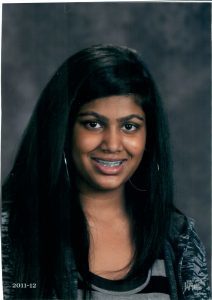
As she grew older, anxiety and depression surfaced, and Pia valiantly went through outpatient and inpatient treatment. For a lot of her life, she felt well and made progress. Other times she would just say, “Mom, I’m struggling,” and those simple words were meant to keep from from asking more. She sometimes said that her goal was to work as a counselor assisting youth suffering similar difficulties, and she earned strong grades and support from her college professors.
Pia made friends easily, worked for social justice, and she often gave her last dollar to homeless people she encountered. Pia was loving and expressive of her feelings toward our family and the extended family in Louisiana and Minnesota. She loved dogs, driving cars, sharing funny videos, reading suspense novels, and cooking seafood dishes.
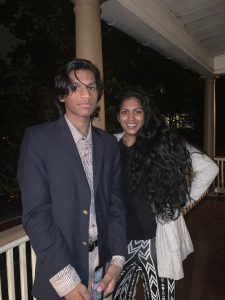
The world lost so much when Pia left it, and I will never forget her passion to help at-risk young women. I am donating in Pia’s name to several nonprofits she didn’t know about, but would have cheered. One group in Maryland is named GEM (Girls Empowerment Mission), which mentors bright girls from economically deprived backgrounds through their high school years and into college. The other charity is ApneAap in India, a group that’s made huge progress reducing prostitution permanently and helping the children of prostitutes get education and housing away from red light districts. Currently they are providing meals during India’s Covid surge to these high-risk families.
It was hard to write this column, and I wept with every paragraph. Twenty-two years ago, I couldn’t have imagined my mother-daughter journey would culminate in such great loss. Yet I’d never want to have missed the gift of trying and tremendous years with my beloved Pia.

The post A Daughter’s Passing appeared first on Sujata Massey.
April 8, 2021
What Makes a Death a Legend?
This post originally appeared on Murder Is Everywhere.
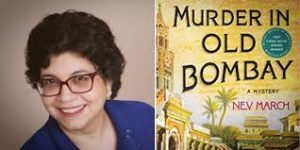
Nev March lives in New Jersey, and I’m in Baltimore. Our only real life meeting was in New York City at the Edgars symposium in 2019. I was there to win the Mary Higgins Clark prize the following evening (though that day, I had no idea!). Nev already knew she was winning the St. Martin’s/Minotaur Mystery Writers of America Best First Crime Fiction award, which results in publication of one’s book the next year.
Nev intrigued me by sharing that Murder in Old Bombay was partly inspired by one of Bombay’s most famous unsolved crimes: the Rajabai Clock Tower Deaths of 1891. I was honored to write the cover blurb for this book. I found that Nev solves the riddle of the deaths by using fictional characters who come together in a way that makes great dramatic and cultural sense. She also introduces us to a fictional Parsi family of great wealth and intelligence, and a clever young Army captain, Jim Agnihotri, who’s hired to investigate their family’s tragedy.
It was no great shock that this book is also nominated for the Edgar Award nominee for Best First Mystery, but it certainly is great news. I don’t know how things could get any rosier for Nev. But from the answers she gave me, it’s clear that she is one of the humblest, hardest working writers around.
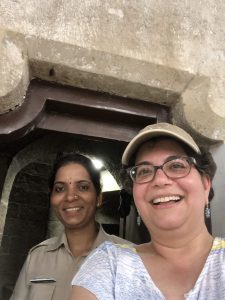 Nev and a policewoman near the clock tower balcony
Nev and a policewoman near the clock tower balconyYou just got nominated for the Barry and Hammett awards! And you’ve got an Edgar nomination for best first mystery. What does the recognition mean for you and your writing journey?
It’s marvelous. When I was writing I didn’t ever imagine Murder in Old Bombay would find such a warm reception. To have a first book out is both surreal and exciting; to have it gain such recognition is enormously rewarding. It also adds a bit of stress, because now my next book needs to match or exceed this level of writing. My writing journey has just begun, so I have to trust that the process works, and that pulling honestly from my truths will be enough. In some ways it’s a bit easier, because I trust my own judgement more.
We’ve talked together about how important books were in your upbringing. In your childhood or teen years, did you want to become a novelist? What happened instead, with your longtime career in the US?
In 1990 my short story “Must There Be Crying?” was published in Target, a children’s magazine in India, followed by “Blue Skies,” a short sci-fi piece. I was in college; writing was considered a hobby, not a career. After earning degrees in economics and psychology, I won a scholarship to a graduate program in the States. For the next twenty years I worked in business analysis, market research and more, then was laid off.
This led to some soul-searching. I’d enjoyed my work, conversations with colleagues and made good contributions—should I seek another position of responsibility or turn to what gave me more joy—writing fiction? Writing won, but it was a few years until it paid off.
I was born Sujata Banerjee, but took the last name “Massey” when I married my American husband. As you know, Massey also is an Indian name, so it’s proved a miracle surname for me as a writer. Was Nev your nickname or strictly a pen name? Tell us how you became “Nev March.” Do you go by Nawaz Merchant in your daily life?
I’ve experienced many forms of racism over these 30 years, and I wanted to give my book a fair chance. A name is a vanity in some sense, a mark of pride that says, “this is mine.” Murder in Old Bombay is like my adult child that has gone into the world. To prevent my name becoming a barrier to its growth, I chose to write under a pseudonym. My nickname was Nav, which I modified to Nev. “Nev” is a nod to Neville Shute, an Australian writer I admired enormously. I took “March” from a childhood favorite, Louisa May Alcott’s Little Women. Jo March wanted to earn a living as a writer, like me!
How did you tap into your talent and get the courage to believe you could write a novel? Was your writer’s group part of it?
Although I’d written four books before 2006, I didn’t know how to market them. So, with two young kids and a full-time job, I put aside creative writing for a decade. Five years ago I joined my local writers’ group, but it was a year and a half later that I wrote Murder in Old Bombay. My writing group was enormously supportive, but also honest, with tough critiques when needed.
What does writing a 135,000 word manuscript in four months’ time look like? Tell us when you awoke, when you slept, and what else happened.
Writing Murder in Old Bombay was addictive. I’d keep seeing a scene repeating in my mind like a video on endless loop. Each time the scene was from a different perspective, or have additional dialog and surprises. I’d write just to get it out of my head! Then the next would spool. I’d go to bed at 2 am and have to return to the PC at 4 because the next scene kept repeating. It was intense and I loved every bit! It hijacked me—I rarely knew what date it was. Terrified that it wasn’t as good as I wanted, I leaned heavily on my friends during those months. Three critique partners provided extensive input, and one of them, Jay Langley, helped me trim the 138,000 word manuscript to the final 115,000 words needed by my publisher. I can’t ever thank them enough!
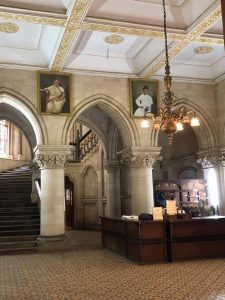 Entrance to the University’s reading room
Entrance to the University’s reading roomYou delve into a true mystery in Bombay, the deaths in 1891 of two young Parsi women who fell from the Rajabai Clock tower on the University of Bombay campus. There were 2 trials with suspects brought forward, but no one was ever convicted. I was deeply struck by the emotion around this case and even refer to it in my next novel, which is set thirty years later. How did you first hear of this crime, and what did it meant to you as a young woman in India? And how did you extract information from more than a century ago?
As a teen, if I tried to do something adventurous (join the hiking club, overnight college trip etc), my parents put the kibosh on it with this phrase: “Remember the Godrej Girls.” It pointed out that girls aren’t safe, even in daylight. Rape was never mentioned, either in public or private. I only knew that something bad happened to girls from my own tiny community.
Decades later I read an article about their deaths and the murder trial, which was the trial of the century in the 1800s Bombay. When the accused with acquitted due to lack of evidence, two petitions were filed by Parsi citizens of Bombay begging to reopen the case. 60,000 Parsis signed the first, 40,000 the second petition. This is astonishing, since there were only 100,000 Parsis world-wide!
To research it, I read articles and newspaper archives—the case was in British newspapers, and biographies of Ardeshir Godrej (the young widower of one of the victims) hoping for more clues. Ardeshir (usually shortened to Adi) fascinated me, because he became a serial entrepreneur, and founded what is now the Godrej Conglomerate. How does a 22-year-old recover from the death of his young bride? I wondered whether he might have solved the mystery by hiring a detective, and thereby found closure. An intensely private man, he wouldn’t have made public his investigation. That’s where my novel began.
The novel’s protagonist is Jim Agnihotri, a dashing young Anglo-Indian military officer. Was he always meant to be the novel’s protagonist? I step out of my exact cultural identity (Indian-German) when writing about India because it feels too unusually specific. What advantage does stepping out of your own Parsi identity to become Jim give you in storytelling?
The moment I “saw” Captain Jim, I knew he’d be the novel’s protagonist. The first scene I wrote was chapter 2: his meeting with Adi. An army man, an officer—I could not understand why he was so deferential to the grieving widower. Then I realized he was mixed race, and it all fell into place. In my mind Captain Jim was astonishingly forthcoming, so I could show his intense loneliness from exclusion.
Parsi writers like Rohinton Mistry, Boman Desai and Bapsi Sidhwa have beautifully portrayed the Parsi community as insiders. I wanted to show my community how they are viewed by others, especially by those who love them, who are traditionally not admitted into the Zoroastrian faith. This loving portrayal allows me to tell tough truths; that those who follow the Zoroastrian path of “good thoughts, words and deeds” may still be bound by old conventions that hurt others deeply. The character of Burjor is based on people I love dearly who I hoped to persuade to a more liberal point of view.
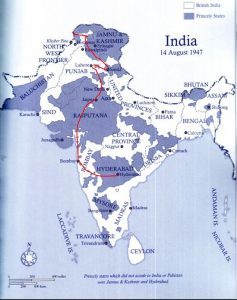
When was the last time you were in India, and when do you hope to return?
I visited India every other year, sometimes three times a year for my parents’ medical care. Mum passed away last year, and Dad is now in the US. Once the covid restrictions are lifted and it is safe to travel, I hope to return and meet my dear aunts and uncles.
Tell us about your next book. Will it feature Jim? Is there a title yet?
No title yet, but I’m working on a sequel set in 1893 Chicago, where millions visit the World’s Fair, the magical Columbian Exposition celebrating America’s progress. Now employed at a Boston detective agency, Captain Jim investigates the murder of a friend on the fairgrounds. The first Parliament of World Religions will be held that summer, while at the same time the World Convention of Anarchists has assembled. What could possibly go wrong? And, yes, what will resourceful Diana do about it?
The post What Makes a Death a Legend? appeared first on Sujata Massey.
March 24, 2021
The Virus is Racism
This post originally appeared on Murder Is Everywhere.
 Memorial to California victims. Photo by Naomi Hirahara.
Memorial to California victims. Photo by Naomi Hirahara.It started with country-blaming.
China flu, Wuhan Flu, Kung Flu. Donald Trump could only think of blaming outsiders, to deflect attention from his own disinterest in controlling a pandemic. Yes, coronavirus was first identified in China. Yet we’ve learned the virus was already in the U.S. and Europe at that time.
The linking of Asians with contagious illnesses and societal problems isn’t new. Many of us can recall the decline of American manufacturing in the 1970s and ‘80s and the rhetoric against evil Japanese auto manufacturers. Our grandparents remember that during World War II, Japanese Americans were forcibly detained in camps, with their properties stolen by white neighbors, during the time they were away. In 1900 San Francisco, Chinese residents were blamed for the bubonic plague and forcibly quarantined in Chinatown. In 1886, hundreds of Chinese-Americans were forcibly expelled from Seattle. In 1871, the country’s largest mass lynching took place in the then-small town of Los Angeles, when 500 rioters angry over the accidental shooting of a white man chased down all the Chinese Americans they could find. Eighteen were killed, and the few men convicted in the deaths were released on a legal technicality and never retried.
Historian Erika Lee and activist-writer Helen Zia spoke on a Washington Post video interview about why Asian blaming is so endemic in this country. The running theme is that sometimes, when there’s a government or business failure, it becomes expedient to blame it on people perceived as outsiders or invaders.
The nonprofit Stop AAPI Hate is recording what they believe is a fraction of the racist incidents against Asians since last March 19, 2020. By February 28, 2021, the total of community-reported incidents was 3,795. Just last week, 21-year-old Robert Aaron Long was arrested on suspicion of murdering eight people, including six Asian women, at massage parlors. What astounds me is that an officer in the Atlanta police who interviewed the suspect said he had an obsession with women, nothing racist. It came to light later that the officer himself had posted on Facebook a photo of a racist T shirt blaming coronavirus on the China.
After lessons learned from the Black Lives Matter movement this last year, it’s painful that the police, and many of the public as well don’t seem to equate violence against women as having the potential to stem from racism. I believe the fetishism of Asian women by Western men has troubling roots in war experiences and colonialism. Belittling females presents little risk of revenge—and a lot of reward.
I grew up in a suburban Minnesota school system where racist bullying was endemic, from my grade school to the junior high and high school. Boys sing-songed “import” at me during the years of the anti-Japanese car backlash. Girls spoke loudly amongst themselves about how ugly my hair was, or that I was too “dark complected” to get a boyfriend.
All that hurt. But I was only flat-out terrified when I left the Midwest for a trip back to the state where I felt loved—California, where my family had briefly lived during a sabbatical year away from Minnesota. I’d rejoined my friends from eighth grade at Martin Luther King Junior High in Berkeley. We were exploring San Francisco. We were laughing and enjoying ourselves. Suddenly, a white man with wild eyes was screeching and snarling and rushed up within inches of my face.
“You dirty alien. Get out of this country. You’re disgusting! You’re ruining us!”
The words I’m sharing aren’t exact, because there was certainly a lot of profanity I blocked out. I also never knew if he’d singled me out because he thought I was Mexican or Asian. But I was a brown 14-year-old girl, five foot one and just a hundred pounds. He was very, very close to me, and while there were plenty of adults around, everyone appeared to be studiously ignoring the man’s existence.
I’d felt joy in California because I felt it was diverse—but there were Californians who didn’t want diversity. Anti-Asian racists go after those they think can’t fight them—and often, this is assumed to be the elderly, children, and females.
Novelist Angie Kim’s opinion piece in the Washington Post lays it out quite well. I think about the Muslim girls and women attacked after Trump assumed office, and the South Asian women and men of all faiths attacked in response to the 9-11-2001 terrorist attacks.
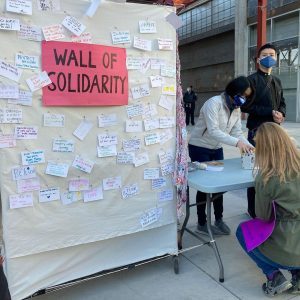 Asians and Allies come together in CA. Photo by Naomi Hirahara.
Asians and Allies come together in CA. Photo by Naomi Hirahara.Last week, Xiao Zhen Xie, a 74-year-old Chinese immigrant from China, was accosted in the same part of San Francisco where I’d been harassed. Like me, she was accompanied by someone standing at a stop light, unable to move because of the traffic. That’s when 39-year-old Steven Jenkins allegedly rushed up and punched her in both eyes. And that’s when she was far more active than I’d been. She managed to grab a board which she used to defend herself against the man—hitting him so hard he fell down and was able to be detained for arrest.
Xiao Zhen Xie fought back. And by flattening her assailant, she probably prevented him from attacking another Asian. He’s suspected of an attack on an 83-year-old Vietnamese man the same day.
Stop AAPI Hate has 5 concrete steps for people who may spot violence in the street in the next few days, weeks or months. It’s far less in-your-face that what I expected. But in the online vigil I attended last week, mourning the victims in Atlanta, I heard the opinion that vigilantism and policing won’t change things. Respect and peace are the way to win.
Take action. Go to the targeted person and offer support.Actively listen. Before you do anything, ask – and then respect the targeted person’s response. If need be, keep an eye on the situation.Ignore attacker. Try using your voice, body language or distractions to de-escalate the situation (though use your judgment).Accompany. Ask the targeted person to leave with you if whatever is going on escalates.Offer emotional support. Find out how the targeted person is feeling and help them determine what to do next.The post The Virus is Racism appeared first on Sujata Massey.
March 14, 2021
The Bombay Prince Goodreads Giveaway!
This is the third mystery in the Perveen series, and I'm so eager to share it with you! I traveled to India to fact check little details about Parsi culture, women lawyers, and Mumbai's historic colleges and hotels. These are the things I care about and have come to learn readers do as well. My research trip for THE BOMBAY PRINCE happened in January-February 2020, the last few weeks before the pandemic hit, and worldwide travel ceased. After that, I locked myself down and rewrote the book many times until I felt it was ready.
I feel so honored by an advance review for this book by Kate Quinn, the NYT bestselling author read it in advance. Kate wrote:
"Perveen is much more than a sari-clad Miss Marple: she's Bombay's first woman lawyer, as well as a keenly intelligent sleuth, a trail-blazing woman balancing the weight of family tradition with her own dreams. Perveen's investigation into the mysterious death of a young university student coincides with the imperial visit of the future Edward III, and the resulting trail of breadcrumbs through royal receptions, street riots, squalid jails and lavish hotels makes for a deliciously satisfying read."
I hope you are rewarded in this giveaway, and no matter what, the book goes on sale June 1, 2021!
March 10, 2021
The Royals, Revealed
This post originally appeared on Murder Is Everywhere.

It seems all about Harry and Meghan this week. But they’ve made me think about some less glamorous people, too.
An Oprah Winfrey interview of Britain’s Duke and Duchess of Sussex aired three nights ago and opened a rare, uncensored view of personal relationships within Buckingham Palace. Among the many disturbing revelations during the interview were the royal couple’s assertion that Meghan was denied the freedom to get psychiatric care, even when suicidal; and that a member of the family made racist comments about their baby, and they were denied security services and many more things senior royals take for granted. Harry and Meghan also expressed pain about cruel and untrue stories about Meghan that flourished in British tabloids that led to a nationalistic rage against her—a situation they believe could have been curtailed if Buckingham Palace had stood behind her.
I had an inkling that things were not right in Kensington Palace, but like most people, I bought the party line that the Sussexes had departed the palace without warning, supposedly blind-siding the Queen. In the interview, the couple made clear there had been months of planning for the departure. The nasty “Megxit” stories were just an extension of the hatchet job done before.
I was surprised and happy when Prince Harry fell in love with Meghan Markle. I’d assumed he’d marry a society or noblewoman—instead, he found happiness with a biracial woman from Los Angeles who already had found success as an actor. Through her blogging and volunteer work, Meghan had proved herself both a feminist and a champion of marginalized people. She was beautiful, inside and out.
Harry and Meghan’s romance also appealed to me because I was once was “Her Majesty’s Subject.” I was born in Sussex to parents from India and Germany. Our family emigrated from England to America in the mid-sixties for two reasons. In the United States, my father could get a professor job based on merit rather than years served at a university. Secondly, my parents feared if we stayed in Britain we would grow up thinking of ourselves as second class citizens. For years, I thought my mother was exaggerating. It wasn’t until much later that my parents shared a few stories of discrimination, and I realized that my hair, skin and name would have stamped me as a remnant of colonization.
Our family built a good life in the United States. I suffered hard years in high school, but I went on to have a deeply gratifying college education. I worked in a dream career in newspaper journalism for five years followed by a lengthy and even more fulfilling career writing mystery and historical fiction. In almost every book I’ve written, there was a British character. I think this is because I consider my birthplace a part of who I am.
I married a college classmate, a white man from the Deep South. After seven years of marriage, we adopted two very brown children. This surprised more than a few people. Our diverse family of four drew attention—whether it was ‘good for you!’ smiles beamed at us from cashiers in the grocery store to flat-out queries if the children were ours or where we adopted them from. Less common, but far more offensive, were unasked-for opinions on the children’s skin color.
I believe what Meghan and Harry are saying about racist experiences in England is true. And in my personal social media feed, comments from British people about this issue are likely to be mocking, cynical, and furious. I’m seeing Harry described as ‘venomous’ and Meghan as a ‘grifter.’ When I look at comments from Americans, I see outrage about racism and refusal to help someone in a mental health emergency. We are an ocean apart.
If the palace were to call me for an opinion, this is what I’d advise.
This situation can be saved—just like most family fights.The remedy is apology. That means the family member or the administrator who denied Meghan the freedom to leave the palace to seek medical help must come forward and admit it. Similarly, the family member who commented on Archie’s skin color owns up to it, rather than let everybody else suffer the suspicion. Harry’s official royal salary should be reinstated, as would the family’s security service, when needed. In return for this, Harry and Meghan would continue charitable visiting appearances around the world, while keeping a private home base. There’s no point in asking the British tabloids to do anything differently.
And that’s why it makes sense to stay in Montecito.
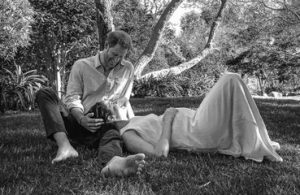
The post The Royals, Revealed appeared first on Sujata Massey.




